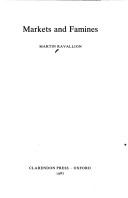This is a study of the economics of famine. Famines have often presented a challenge to economic thought. Past debates have concerned the importance of aggregate food availability and the role of markets and governments in allocating limited food. This book applies some modern methods of economic investigation to these issues. A theory is presented which shows how the sharp increases in mortality observed during famines can arise without a decline in aggregate food availability. Much of the book is devoted to a detailed empirical study of the causes of the adverse changes of food distribution which led to...Read more
This is a study of the economics of famine. Famines have often presented a challenge to economic thought. Past debates have concerned the importance of aggregate food availability and the role of markets and governments in allocating limited food. This book applies some modern methods of economic investigation to these issues. A theory is presented which shows how the sharp increases in mortality observed during famines can arise without a decline in aggregate food availability. Much of the book is devoted to a detailed empirical study of the causes of the adverse changes of food distribution which led to high mortality during the 1974 famine in Bangladesh. The results throw new light on the way markets work during famines and on the effects of policies aimed at famine relief or prevention.
- ISBN10 0198285140
- ISBN13 9780198285144
- Publish Date 26 March 1987
- Publish Status Out of Print
- Out of Print 14 March 1991
- Publish Country GB
- Imprint Oxford University Press
- Format Hardcover
- Pages 208
- Language English

